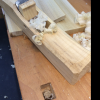I've always thought plane stops were a good idea; but if you drag your plane back they don't work very well. Light bulb comes on and plane stops work because you don't drag your plane back.
Question is; is the effort to (I'm currently planing 39" long red oak about 6" wide) pick up my #8 to preserve the blade less than the effort spent to keep it sharp if I drag it back?





 Reply With Quote
Reply With Quote







